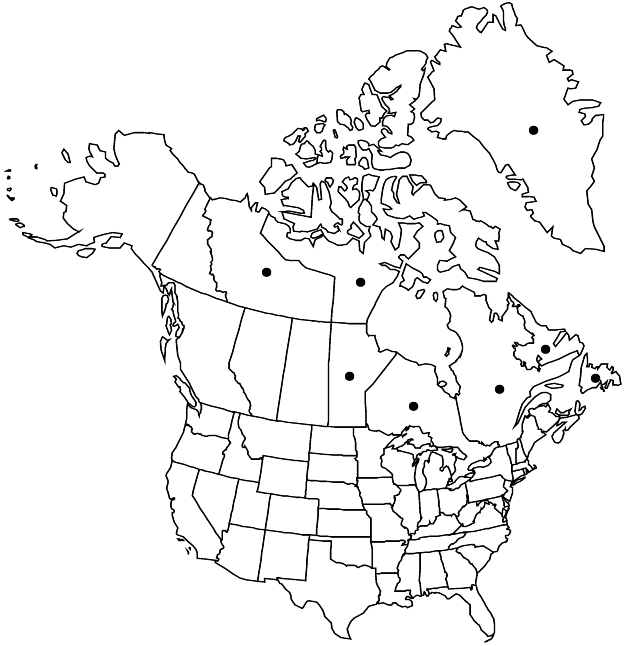Primula stricta
in G. C. Oeder et al., Fl. Dan. 8(24): 1, plate 1385. 1810 ,.
Plants 8–15 (–19) cm, herbaceous; rhizomes thin, short; rosettes not clumped; calyx and upper scape usually at least somewhat farinose. Leaves not aromatic, indistinctly petiolate; petiole narrowly winged; blade without deep reticulate veins abaxially, oblanceolate to spatulate, 1–6 × 0.3–1.1 cm, thin, margins entire or slightly denticulate, apex obtuse to acute, surfaces glabrous. Inflorescences 2–9-flowered; involucral-bracts saccate, ± equal. Pedicels erect, thin, 1–8 mm, length 1–1.5 times bracts, stiff. Flowers homostylous; calyx green or with purple stripes, campanulate, 4–6 mm; corolla lavender, tube 4–7 mm, length ± 1 times calyx, eglandular, limb 4–8 mm diam., lobes 2–4 mm, apex emarginate. Capsules ovoid-ellipsoid, length 0.9–1.2 times calyx. Seeds without flanged edges, reticulate. 2n = 126, 88–136.
Phenology: Flowering summer.
Habitat: Coastal regions, especially in dunes, marshes, and beach ridges, less commonly inland along streams
Elevation: 0-300 m
Distribution

Greenland, Man., Nfld. and Labr., N.W.T., Nunavut, Ont., Que., Europe
Discussion
Primula stricta is an arctic coastal species originally described from plants collected in Norway. Although the later description of P. hornemanniana Lehmann is clearly based for the most part on plants that are P. stricta, the illustration and discussion by Lehmann include an unfortunate mix of P. stricta and the European diploid P. farinosa. Lehmann’s treatment was used as a standard for the concept of P. stricta by some European and North American botanists, which led to considerable confusion and to many misidentifications. Additional problems have resulted from confusion with other arctic species: the name P. farinosa var. groenlandica Pax has been used for plants of P. stricta and P. egaliksensis; Alaskan and Yukon plants called P. stricta should be placed under P. anvilensis, P. borealis or P. incana; and east of Hudson Bay, P. stricta has been confused with both P. egaliksensis and P. laurentiana. Material from the Canadian Rockies can be P. egaliksensis, P. incana, or P. mistassinica; fruiting plants are often difficult to work with because they lack the diagnostic characteristics of plants in flower.
In its typical form, Primula stricta is a relatively short plant with capitate umbels of homostylous flowers, emarginate corolla lobes, and broadly elliptic capsules barely longer than or slightly shorter than the sparingly farinose calyx. These characteristics distinguish it from other members of sect. Aleuritia. While P. stricta is undoubtedly of allopolyploid origin, it is not yet clear whether the progenitors are the North American species P. laurentiana (8x) and P. incana (6x), or their octoploid and hexaploid European counterparts P. scandinavica and P. scotica; dual origins are a strong possibility (A. Guggisberg et al. 2006); no clear morphological differences are detectable between most European and North American material. Variant high-level chromosome counts from the European arctic suggest that dysploidy may be common in some populations of this species at high latitudes and evolutionary interactions between P. farinosa, P. scandinavica, and P. stricta are still in flux (U.-M. Hultgård 1993). In northeastern Canada, P. laurentiana and P. stricta can be ecologically sympatric and intergrade morphologically; genetically mixed populations are likely.
Selected References
None.
Lower Taxa
No values specified."-1.2timescalyx" is not declared as a valid unit of measurement for this property."-1.5timesbracts" is not declared as a valid unit of measurement for this property."thin" is not a number."timescalyx" is not declared as a valid unit of measurement for this property.